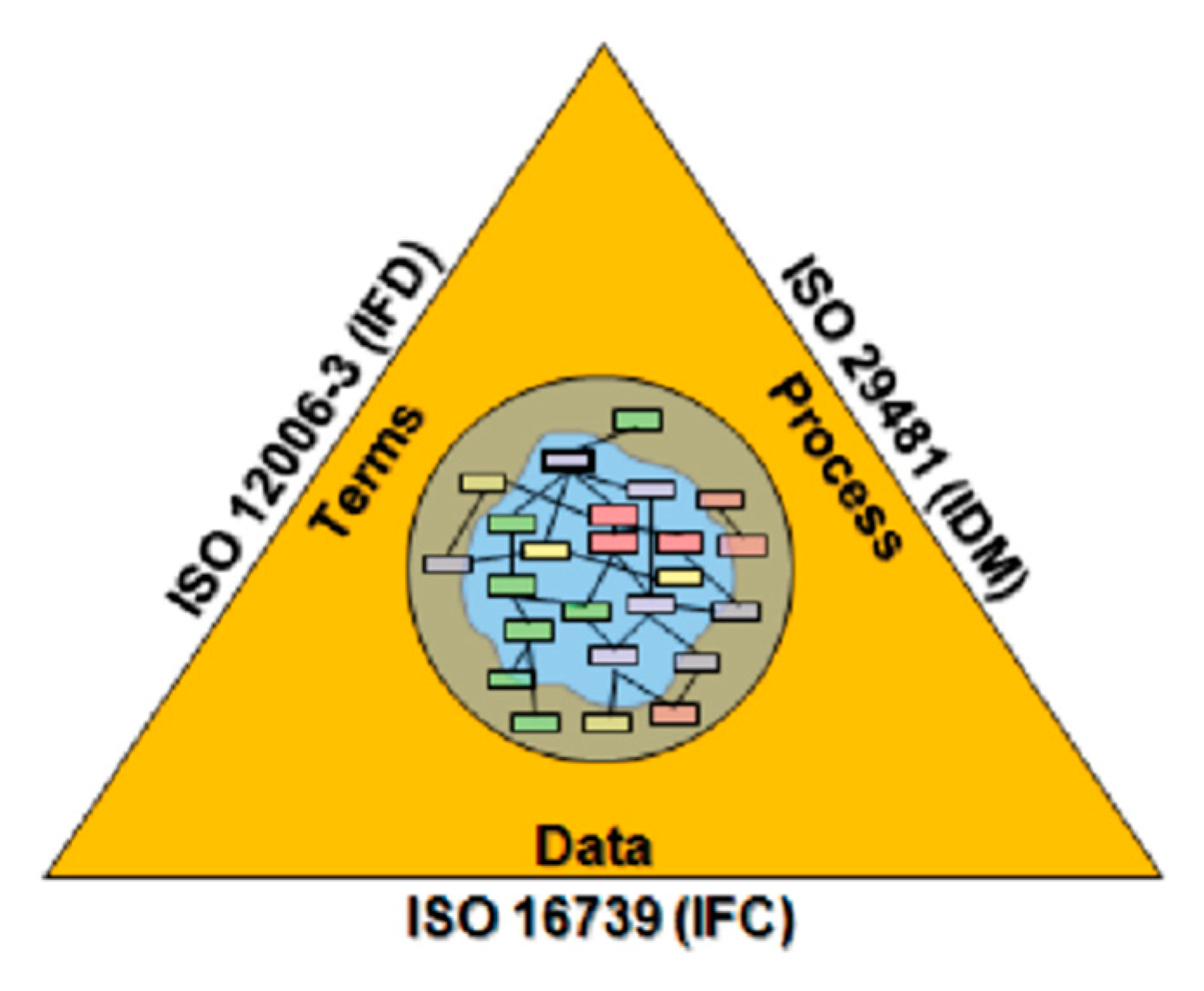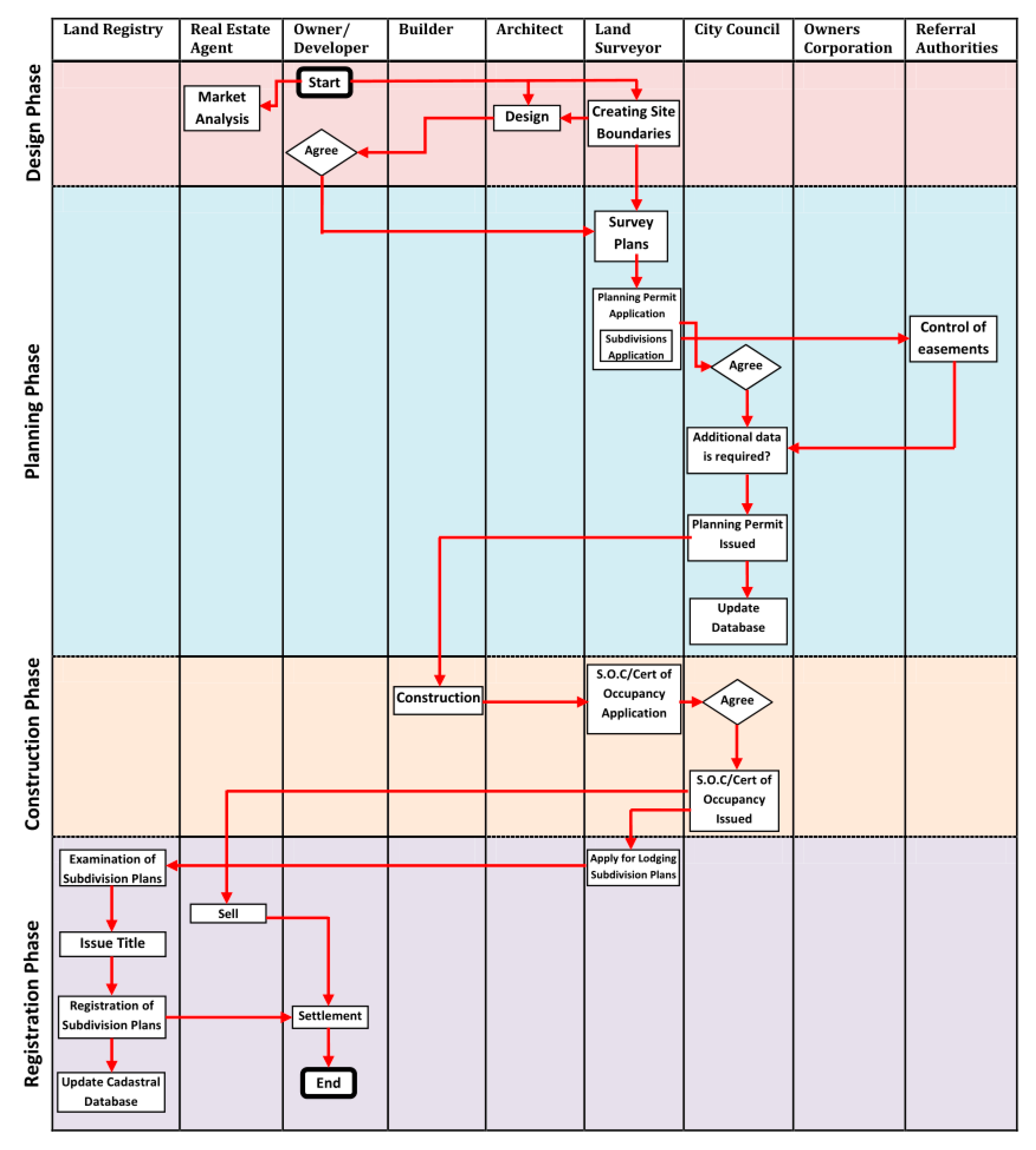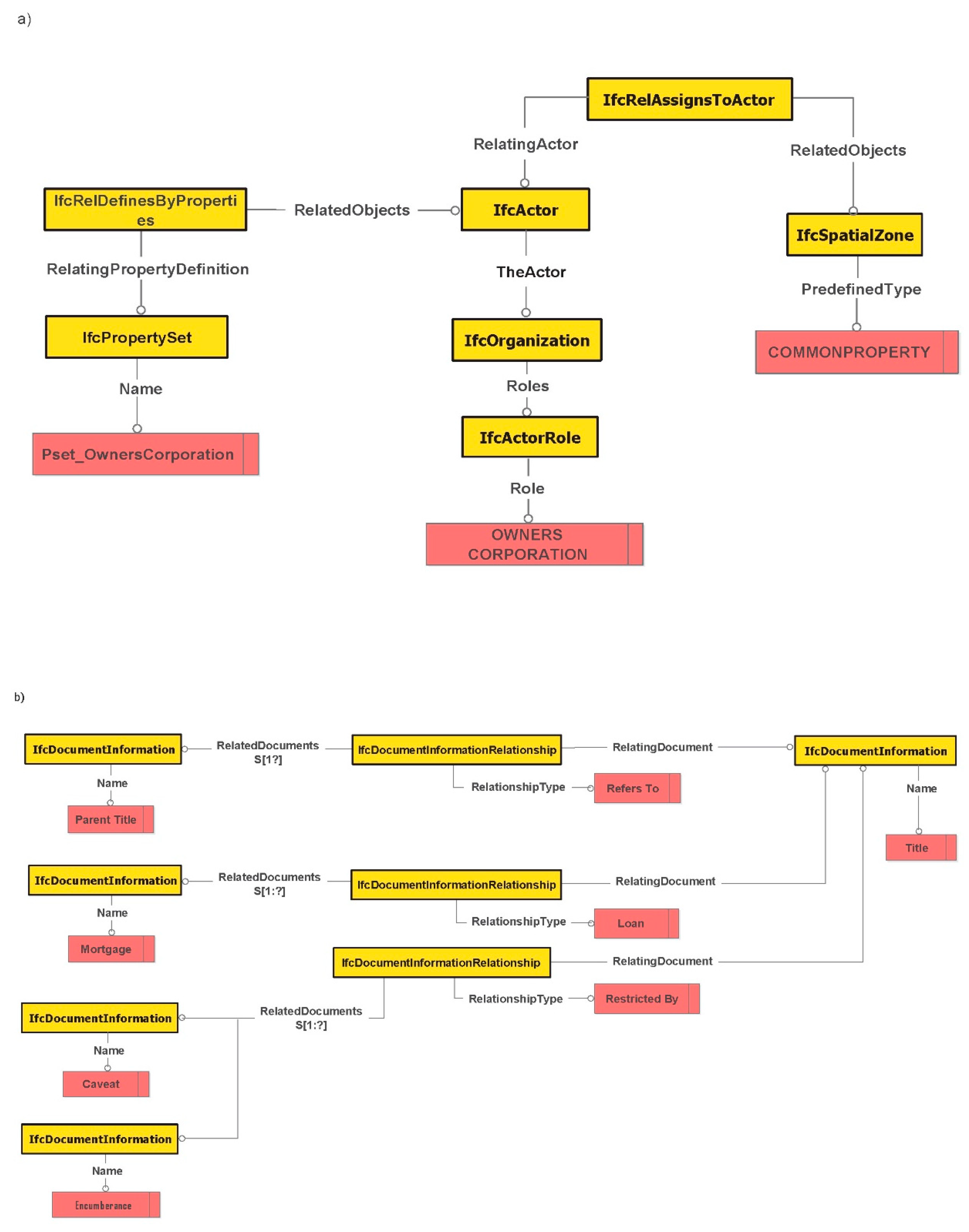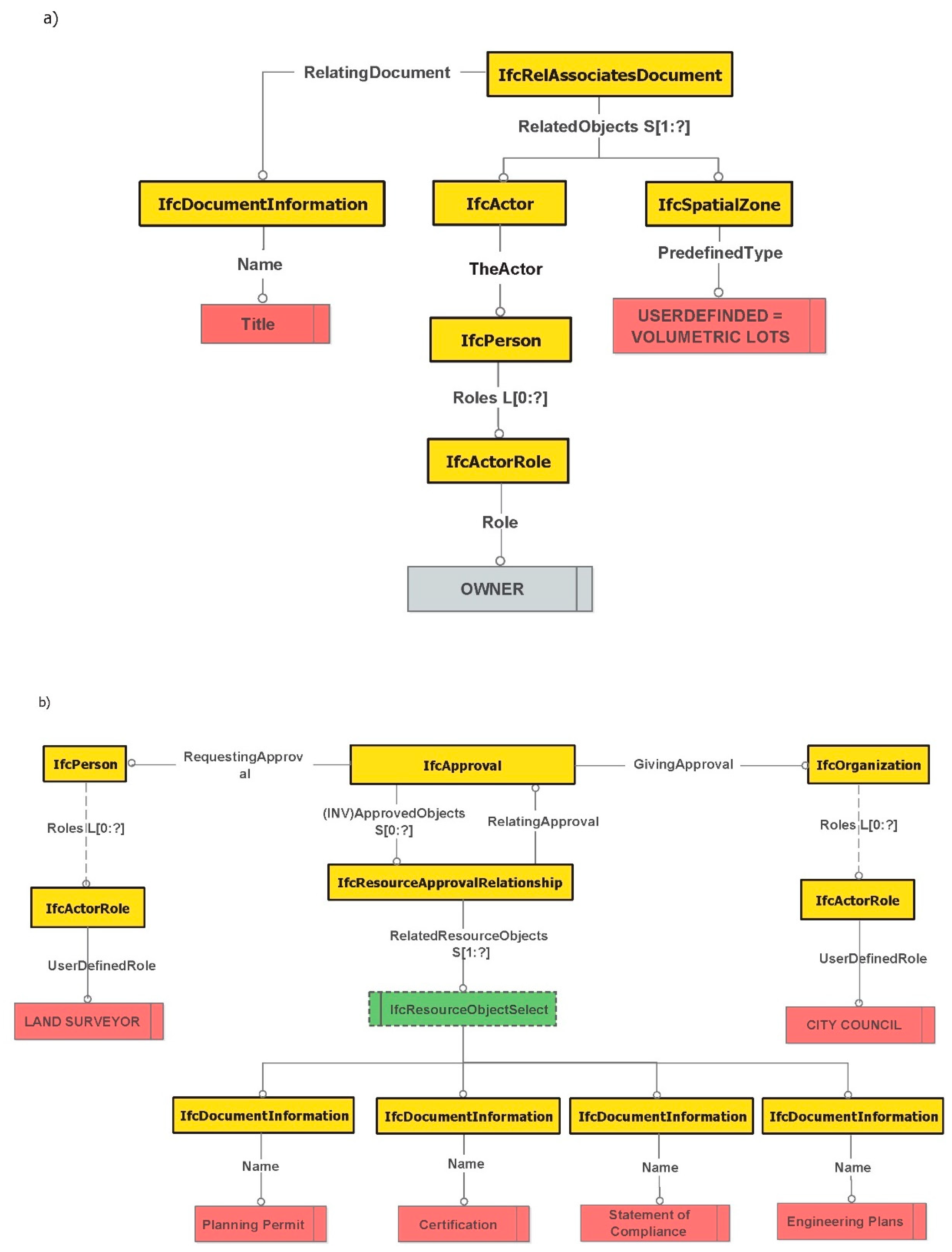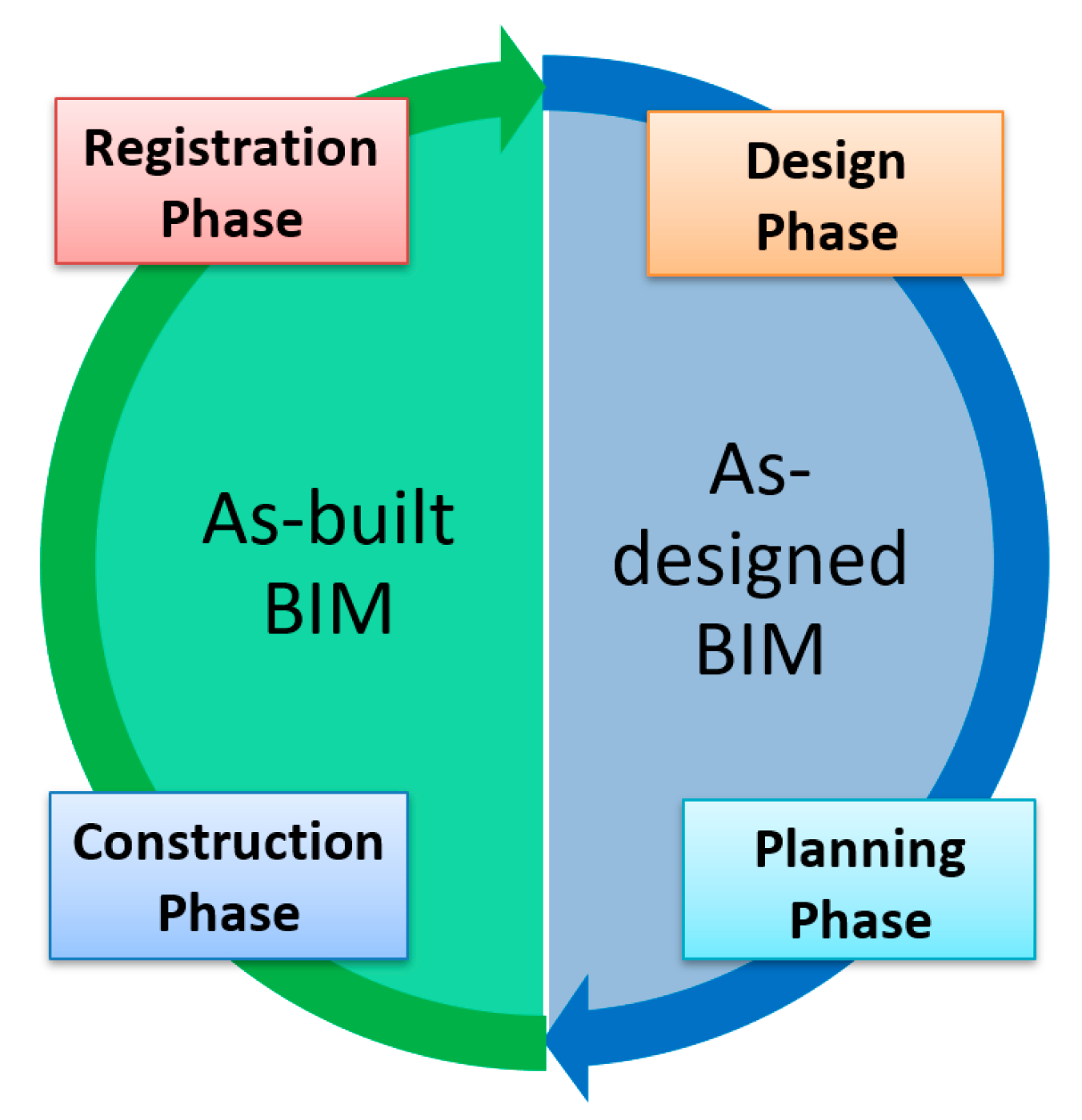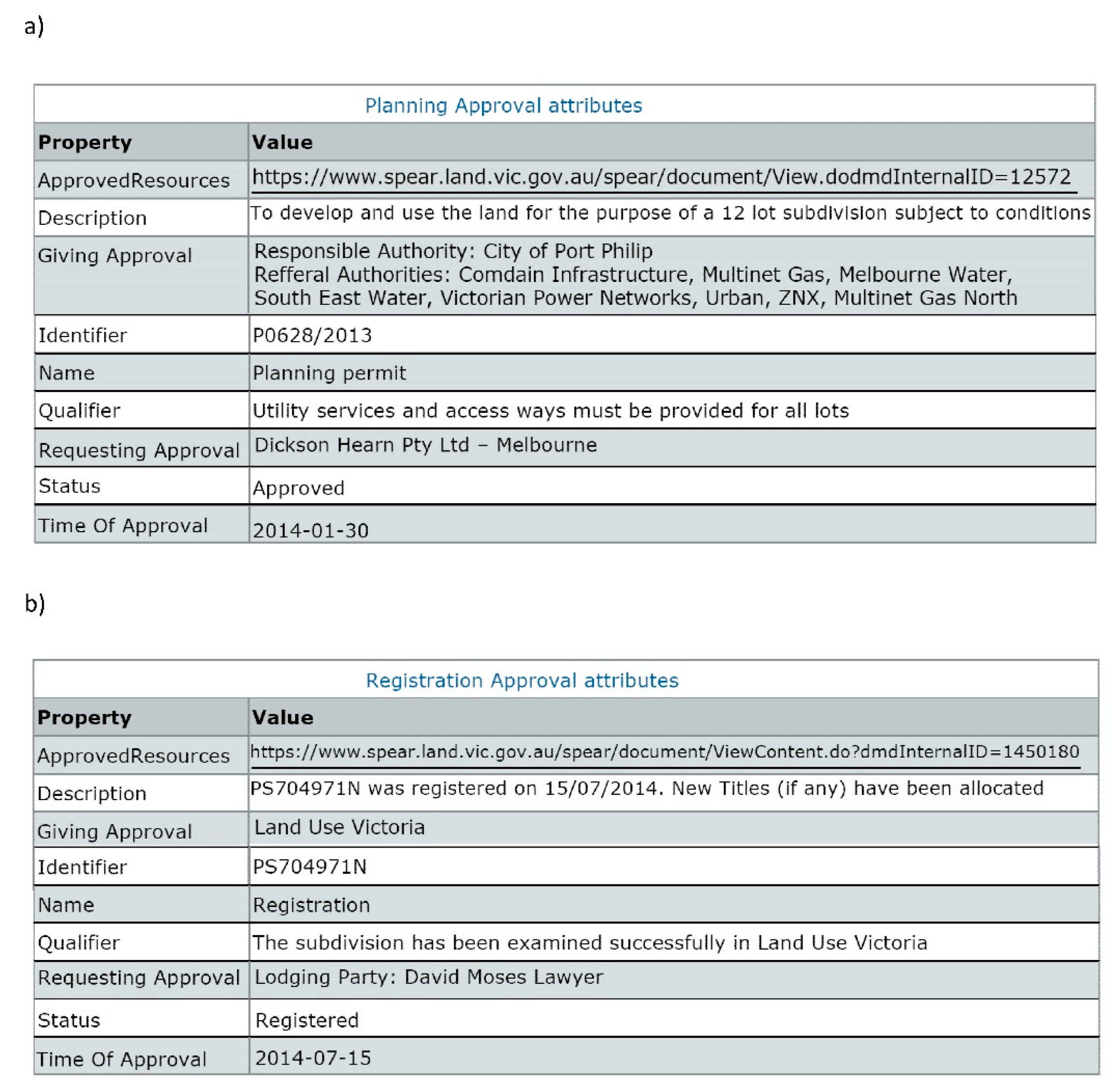1. Introduction
The growing population and lack of available land in urban areas has led to an intensive property development above and below the ground surface [
1]. Decision-makers require access to an efficient land and property information system, which is 3D, spatially accurate, and dynamic containing interests in land (rights, restrictions and responsibilities—RRRs), according to the Cadastre 2034 Strategy for Australia and New Zealand, to manage spatial and legal complexities of urban environments [
2].
In addition, the emergence of complex multi-story structures in modern societies has resulted in significant challenges in data communication and management within current building subdivision workflows. These workflows typically include a wide range of stakeholders (e.g., cadastral surveyors, planners, developers, architects, councils, referral authorities, land registries, building managers, real estate agents, solicitors, and the public) that exchange 2D cadastral plans (in PDF or TIFF formats) and other relevant documents over the lifespan of a building subdivision application.
Several researchers have suggested using 3D models based on BIM to address issues that are related to fragmented 2D paradigms and improve the current building subdivision workflows [
1,
3,
4,
5,
6]. This paper aims to contribute to this research domain by conducting a case study in Victoria, Australia, which explores the feasibility of a BIM-driven approach to support the building subdivision workflow in an integrated 3D digital environment.
Australia is among the most urbanized countries in the world [
6]. Amongst the Australian jurisdictions, Victoria was selected as a good choice for understanding the current building subdivision workflows, as it is the most populated state with many urban developments. Victoria, with the population of 6,430,000 [
7], is currently the fastest growing state in the country, with more than 2000 people moving to this state every week. In 2019,
$78.9 billion of state capital projects have been commenced, developed, or delivered [
8].
The Victorian Department of Environment, Land, Water, and Planning (DELWP), through Land Use Victoria (LUV), is responsible for all land information and administration activities in Victoria, including the registration of land transactions, property information, surveying, valuation, geographic names, spatial services, government land, and the government land monitor. LUV is also responsible for maintaining the Victorian cadastre, which is currently a 2D representation of the state’s property boundaries, based on property title information, and it provides the foundation data for Victoria’s primary mapping and spatial information systems and services.
Figure 1 illustrates the Victorian land administration system modernization journey. Before the 1990s, cadastral plans were all lodged in paper format. Vicmap Property, the State Digital Cadastral Database (DCDB), was created in the early 1990s from the digitization of paper-based map records that are held by Melbourne Water (metropolitan area) and the state government (rural area). Vicmap Property comprises more than 3.3 million land parcels and associated property attributes, such as the lot and plan number, and crown description, in the State of Victoria.
In 2004, an online platform: ‘Surveying and Planning through Electronic Applications and Referrals (SPEAR)’ was developed to allow for subdivision planning permit and certification applications to be compiled, lodged, managed, referred, approved, and tracked online, anytime. SPEAR streamlined the subdivision process in Victoria and it replaced the paper plans with PDF plans.
According to
Figure 1, by 2013, SPEAR supported the digital submission of cadastral plans in digital format (LandXML), namely ePlan [
9]. All of the 2D plans under the Subdivision Act 1988 [
10] are supported in ePlan. However, strata plans (building subdivisions) are not yet supported in ePlan.
In 2019, another major milestone was reached when LUV invested $45 million in the Digital Cadastre Modernisation Project to upgrade the digital cadastre, ensuring that one of the state’s most important datasets is accurate, useful, and easy to maintain.
The investigations around the 3D digital cadastre to support the building subdivisions in an ePlan format commenced in 2014. A 3D digital cadastre is expected to facilitate the registration process, save time and cost, increase transparency in land and property transactions, and improve land use and management [
11,
12,
13,
14,
15,
16,
17]. For example, in a 3D digital cadastre, the overlapped spatial units can be validated, and geometries can be checked to ensure that rights are secured and disputes minimized [
18,
19].
While there have been scientific research projects around the world to enable cadastre with 3D digital technologies [
3,
20,
21,
22,
23,
24,
25], these studies often address specific aspects of cadastre, such as 3D visualization, 3D validation, 3D storage, and 3D data modelling. As a result, a roadmap was required for integrating these initiatives and identifying the critical steps towards the transformation of the existing cadastre system into an operational 3D digital cadastre system for Victoria.
Accordingly, a roadmap was developed for implementing the Victorian 3D digital cadastre by 2025 [
26]. The roadmap recommends the replacement of PDF building subdivision plans with 3D cadastral data and the development of a digital and integrated building subdivision workflow to accommodate 3D data.
1.1. Research Problem
In Victoria, regulations allow for registering overlapped RRRs in 3D under the Subdivision Act 1988. These RRRs are recorded and registered in paper or PDF-based plans while using floor plans and cross-sections. As illustrated in
Figure 2, the building 3D model in a BIM format is downgraded to a PDF and then to a TIFF image throughout the lifespan of building subdivision and registration in Victoria.
The current 2D PDF-based approach for exchanging cadastral data among the Victorian land administration stakeholders (e.g., planners, developers, architects, councils, real estate agents, strata managers, utility companies, the public) and visualizing RRRs has resulted in some limitations, as summarized below:
Plan preparation is complex and often results in queries (e.g., what are the ownership boundaries? What is the extent of a common property?) and errors (e.g., lack of required cross-section diagrams).
The examination process is labor intensive and it requires technical expertise.
Land administration stakeholders cannot readily and efficiently use information.
Queries, analyses, and decision-making are possible, but not efficient.
Difficult for the public to understand their RRRs.
Plan interpretation between two parties can be different.
The research problem underpinning this paper can be summarized as the current building subdivision workflow in Victoria is predicated on silo-based and fragmented 2D approaches that do not provide an environment for stakeholders to share, document, visualize, analyze, interpret, and reuse 3D digital cadastral data over the lifespan of a building subdivision project.
1.2. Research Aim
There is a need for the Victorian subdivision workflow to shift from a 2D PDF-based approach to a 3D digital integrated approach to address the above-mentioned research problem. Therefore, this study aims to explore the potential of using BIM (the 3D data prepared by architects at the beginning of building subdivision process, as shown in
Figure 1) to support the building subdivision workflow, as recommended by the Victorian 3D digital cadastre roadmap.
The remainder of this paper is structured, as follows.
Section 2 provides an overview of relevant research experiences regarding the workflows developed for a 3D digital cadastre. The research methodology has been discussed in
Section 3.
Section 4 explains the case study outcomes.
Section 5 provides a set of criteria for comparing the current and proposed building subdivision workflows and discusses the findings. The paper concludes in
Section 5 with a summary of findings and direction for future research.
2. Review of Relevant Literature
The goals of land administration systems are similar in all countries: every society needs a system that provides information on land ownership, which offers additional documentation required over the entire lifecycle of the land subdivision. Therefore, land ownership is the main focus of land administration systems and documents provide the evidence to support land administration processes. The processes are needed to update ownership RRRs attributes and restructure space by changing the shape and number of the parcels [
27]. This signifies the fact that understanding, using, and improving a cadastral system requires knowledge on the cadastral processes [
28].
Urban land is characterized by the dominant existence of multi-story buildings. The current workflows for subdividing land and property ownership in multi-story buildings include various 2D datasets and documents exchanged between different actors. The fragmented nature of these workflows has led to significant communication and management issues in various stages of complex building subdivision projects. Therefore, more integrated approaches, such as BIM, are being explored for improving communication and collaboration among actors.
BIM is a new integrated process that is increasingly being adopted by the Architecture, Engineering, and Construction (AEC) sector to describe, model, and publish all of the documentation required for constructing buildings and complex structures [
29]. It is becoming a dominant paradigm to provide a spatially, temporally, and semantically accurate multi-dimensional data environment for facilitating communication and collaboration in the AEC industry. BIM is a multidisciplinary process for improving communication over the design, construction, and maintenance phases of complex developments. The key result of the BIM process is a BIM product that includes a rich spatial and semantic description of all assets within a development [
30]. This digital product relies on information that is captured and curated by a wide range of stakeholders at important milestones of the project lifecycle. The BIM process has created a significant paradigm shift in the AEC industry over the last decade by introducing an integrated approach for communicating and sharing building information [
31]. The BIM process has changed the traditional document-driven methods of collaboration to 3D digital model-based workflows in the AEC industry [
32].
The current BIM platforms use their own proprietary data formats and workflows to manage BIM data. However, these specific workflows and data formats may not interact well over the entire lifecycle of a building subdivision. Therefore, open BIM standards and workflows have been developed to resolve this issue. Open BIM standards and workflows provide a universal mechanism for supporting integrated design, realization, and operation of buildings [
33]. The objective of open BIM is achieving an improved planning, design, construction, operation, and maintenance process while using a standardized machine-readable information model for each facility, new or old, which contains all appropriate information, created or gathered, about that facility in a format useable throughout its lifecycle by all. As depicted in
Figure 3, open BIM has three major parts: (1) Information Delivery Manual (IDM), (2) International Framework for Dictionary (IFD), and the (3) Industry Foundation Classes (IFC) data model. IDM is a standard for the processes of the work [
34], IFD is a standard for the terminology that is used in the processes [
35], and IFC is a standard data model for data management and information exchanges [
36].
BIM can play a critical role in realizing 3D land administration systems [
6]. As opposed to the traditional 2D-based practices, BIM can provide much more detailed information related to 3D cadastral purposes; however, sometimes the information in BIM can be too detailed, and a simplification process is required [
37]. Atazadeh at al. [
14] extended BIM to support the digital management of 3D cadastral data resulting from building subdivisions. Relevant spatial and physical elements within the open BIM data model, known as IFC, were identified as potential entities that are extended to support 3D cadastral data management within the BIM environment. Their main contribution was extending the concept of spatial zones and space boundaries in IFC to lay the foundation for managing complex 3D cadastral spaces [
38,
39]. They implemented a prototype model to emphasize the feasibility of the extended BIM-based data model for land administration and then proved the effective visualization and management of ownership arrangements in complex urban areas. In the context of the Swedish jurisdiction, the feasibility of BIM has been investigated for the 3D cadastre [
40,
41]. In the Netherlands, Stoter et al. [
42] proposed an implementation of a 3D registration of 3D property rights that were fitted to the LADM standard.
The lifecycle of 3D cadastral spaces and their associated rights, restrictions, and responsibilities is made up of many different parts and substages [
43]. The submission of 3D BIM in an IFC format would allow for data to be digitally archived, remain available and accessible in the long term and be stored in a machine-readable data model. Where PDF merely documents the graphical appearance of a work in a printer friendly environment, IFC allows for publishing the underlying semantics [
3]. Oldfield et al. [
5] investigated using BIM as the input data for 3D cadastre. According to their research, obtaining data is only one part of the process for moving from 2D to 3D land administration systems. An efficient collaborative workflow, preferably digital, also needs to be developed. This digital workflow would determine what the 3D Cadastre needs from a 3D BIM and the process of extracting it in addition to exchange requirements. They confirmed that IFC would need to be enriched further to satisfy the requirements of cadastral legal spaces. Enriching IFC would enable data for a 3D cadastre to be extracted from both as-designed and as-built BIMs.
Over the past decade, researchers around the world have been investigating the incorporation of 3D cadastral data into land subdivision workflows. These workflows will vary case by case from country to country and they will be driven by user needs, market forces, the legal framework, and what technology is available [
43]. Guo et al. [
44] discussed that, similar to the traditional 2D cadastral business in the Shenzhen city of China, the 3D business workflow is divided into three steps: project preliminary, project design, and project construction. In the Dutch jurisdiction, 3D data and collaboration are crucial in the creation and success of a 3D cadaster [
3]. 3D spatial units can be obtained from enriched IFC files, which make property units explicit and submitted as part of digital permit applications. Oldfield et al. [
5] proposed a new IDM-based workflow for registering 3D legal spaces in the context of the Dutch jurisdiction. The workflow focused on the efficient communication of cadastral data requirements between project developers and authorities by obtaining 3D legal spaces from BIM models. One issue with the proposed workflow is that it did not distinguish the specific acting roles performed by various authorities that are involved in the entire subdivision workflow. For instance, the role of responsible authorities, such as councils, was not distinguished from referral authorities, such as utility companies.
More recently, Oldfield et al. [
3] developed a coordinated process for requesting and granting building permits while using IDM-based workflows. The interactions between project developers and municipalities are mapped onto two phases: pre-construction and post-construction. In these interactions, the assumption was that the building approval process relies on BIM models that are embedded with spatial units, RRRs information, and survey measurements. In the pre-construction phase, the as-designed BIM models are used for granting or declining the building permit. In the post-construction phase, as-built BIM models are examined to finalize a building permit application. Using XML-based tools was also suggested for automating multi-actor collaboration and communication during the process of a building permit application.
The above reviewed investigations indicate that there is limited research regarding the viability of a BIM environment to support the entire lifecycle of a building subdivision workflow. In the specific case of the Victorian state in Australia, there is no single study that looked at developing a BIM-driven approach for managing building subdivision workflows. Therefore, in the next section, we will develop a generic approach for supporting a 3D model-based subdivision workflow that is predicated on the BIM environment.
5. Discussion
The BIM-driven approach, as proposed in
Section 4, provides a new window of opportunities in managing the entire lifecycle of building subdivision processes. While the current subdivision workflows rely on 2D-based fragmented document sharing and exchange, the BIM-driven subdivision workflow that is proposed in this study provides an integrated and common data environment to facilitate communication and collaboration among a wide range of stakeholders that are involved in the various phases (including design, planning, construction, and registration) of building subdivision. To compare the current and proposed building subdivision workflows, as discussed in
Section 4, the following set of criteria was developed:
support of international standards;
support of digital data sharing and re-use;
support of data integrity;
support of data analysis;
support of 3D data visualization;
support of plan pre-lodgment validation;
support of digital plan examination;
support of cadastral map base update automation; and,
ease of RRRs interpretation.
Table 6 provides a comparison between current and proposed workflows against the above-mentioned set of criteria.
As previously discussed, SPEAR has significantly streamlined the land and building subdivision process in Victoria; however, the subdivision process itself is not based on international standards. The proposed workflow bridges this gap by aligning the subdivision process with the BIM standards. As opposed to the current fragmented building subdivision data structure in SPEAR (multiple PDF files for plans and associated documents) that has led to significant communication issues in various stages of complex building subdivision projects, BIM will provide an integrated environment that improves communication and collaboration among all the actors (stakeholders).
The proposed workflow aims to prevent BIM from becoming electronic waste by effectively making use of the rich dataset that was prepared by the architects at the beginning of building subdivision process. However, the proposed workflow needs to ensure that the as-built BIM models replace the as-designed BIM models when the building subdivision application gets released at land registry (LUV) for examination and registration purposes.
LUV is currently investigating the IP issue for sharing both ePlans registered in SPEAR and ePlans that were created through the digital cadastre modernization project with the subdivision process stakeholders. The potential solution will also be applied to BIMs being exchanged amongst the subdivision stakeholders in the proposed workflow.
Analyzing the data available in PDF format is not efficient. In comparison, BIM provides a rich data environment that captures complex relationships between legal boundaries, ownership arrangements, and their counterpart physical elements, and thus provides spatial and non-spatial queries capability [
49].
The Victorian 3D digital cadastre roadmap, as introduced in
Section 1, has considered the development of 3D data validation and examination services. The proposed workflow would enable surveyors to undertake a pre-lodgment validation check to identify the potential errors in their 3D building subdivision models, which results in minimizing requisitions during the examination process. Examples of validation checks include clash detection, title boundary consistency between created and cancelled parcels, and parcel geometry closure [
49]. In addition, the proposed workflow will support using BIM models in a digital plan examination platform that has the provision of automating some of the plan examination checks (e.g., survey re-establishment) through overlaying the 3D model on top of the digital cadastre map base in an intuitive environment.
Maintaining the digital cadastre map base using PDF plans is very challenging. SPEAR advises surveyors to upload their CAD files to their applications; however, surveyors either ignore this optional requirement, or provide CAD files in different structures and formats. BIM will standardize the structure and format of digital building subdivision plans, which leads to facilitating the map base maintenance process in the future.
Following the current 2D PDF-based visualization of RRRs, the two most common questions that LUV receives from the public include: (a) What are my ownership boundaries? and (b) What is the extent of the common property? The proposed workflow will simplify the interpretation of subdivision plans through visualizing 3D models in web-based, virtual reality (VR), or augmented reality (AR) applications [
55].
All building subdivision stakeholders need to adopt some technical and institutional changes, which will enforce extra cost to their business, in order for the proposed workflow to be implemented within SPEAR and become fully functional in Victoria. Examples include the cost for hardware/software upgrade, building new infrastructure to work with BIM models, learning new skills and technologies, hiring skilled staff, capturing 3D data from the field, etc. Surveyors will need to capture 3D data and prepare the as-designed and as-built BIM models containing RRRs. Councils will need to have the required skills and infrastructure to assess BIM models for issuing planning permits and filling in relevant IFC attributes. Similarly, the Referral Authorities will need to have required skills and infrastructure to visualize BIM models, locate their assets within them, and fill in the required IFC attributes. LUV will need to enhance SPEAR to accept BIM lodgments. Additionally, some new services, such as BIM validation, visualization, and examination, need to be developed within SPEAR. In addition to technical and institutional changes, some legal changes will be required that should be managed by LUV, e.g., BIM models replacing PDF plans in the contract of sales and dispute resolution processes.
Our case study was conducted in Victoria, Australia; however, our approach for developing a BIM-driven workflow can be adapted for other countries or states. The cadastral system of each country or state is unique. A good understanding of building subdivision data and process requirements in that jurisdiction is required to use the proposed workflow for building subdivisions in the context of another jurisdiction.


